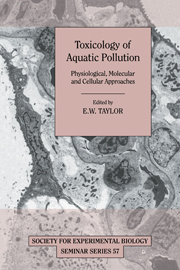Book contents
- Frontmatter
- Contents
- List of contributors
- Preface
- Water chemistry at the gill surfaces of fish and the uptake of xenobiotics
- Bioaccumulation of waterborne 1,2,4,5-tetrachlorobenzene in tissues of rainbow trout
- Dietary exposure to toxic metals in fish
- The physiology and toxicology of zinc in fish
- Lethal and sub-lethal effects of copper upon fish: a role for ammonia toxicity?
- The physiological status of brown trout exposed to aluminium in acidic soft waters
- Physiological and metabolic costs of acclimation to chronic sub-lethal acid and aluminium exposure in rainbow trout
- Physiological effects of nitrite in teleosts and crustaceans
- Metallothioneins in fish: induction and use in environmental monitoring
- Oestrogenic substances in the aquatic environment and their potential impact on animals, particularly fish
- Effect of genetic toxicants in aquatic organisms
- In vitro toxicology of aquatic pollutants: use of cultured fish cells
- Principles governing the use of cytochrome P4501A1 measurement as a pollution monitoring tool in the aquatic environment
- Index
Physiological effects of nitrite in teleosts and crustaceans
Published online by Cambridge University Press: 20 May 2010
- Frontmatter
- Contents
- List of contributors
- Preface
- Water chemistry at the gill surfaces of fish and the uptake of xenobiotics
- Bioaccumulation of waterborne 1,2,4,5-tetrachlorobenzene in tissues of rainbow trout
- Dietary exposure to toxic metals in fish
- The physiology and toxicology of zinc in fish
- Lethal and sub-lethal effects of copper upon fish: a role for ammonia toxicity?
- The physiological status of brown trout exposed to aluminium in acidic soft waters
- Physiological and metabolic costs of acclimation to chronic sub-lethal acid and aluminium exposure in rainbow trout
- Physiological effects of nitrite in teleosts and crustaceans
- Metallothioneins in fish: induction and use in environmental monitoring
- Oestrogenic substances in the aquatic environment and their potential impact on animals, particularly fish
- Effect of genetic toxicants in aquatic organisms
- In vitro toxicology of aquatic pollutants: use of cultured fish cells
- Principles governing the use of cytochrome P4501A1 measurement as a pollution monitoring tool in the aquatic environment
- Index
Summary
Introduction
Nitrite is known to be toxic to both vertebrates and invertebrates. In humans and other terrestrial animals, prime concern has been on pathophysiological consequences of dietary nitrite intake. Aquatic animals take up nitrite directly from the ambient water, which typically causes higher internal nitrite concentrations than in terrestrial animals. Since nitrite can build up transiently in many aquatic habitats either naturally or as result of anthropogenic activities, the sub-lethal and lethal effects of nitrite attracts both ecophysiological and ecotoxicological interest. One prime toxic action of nitrite is that it oxidizes haemoglobin to methaemoglobin. Fish can, however, accommodate relatively high levels of unfunctional haemoglobin without mortality. During nitrite exposure, mortality may be associated with both high and only moderately elevated methaemoglobin levels (e.g. Margiocco et ai, 1983; Eddy & Williams, 1987). This inconsistency between the degree of methaemoglobinaemia and mortality suggests that additional effects must be involved in the toxicity of nitrite. A similar argument applies to aquatic crustaceans, whose respiratory pigment, haemocyanin, is less affected by nitrite than haemoglobin. An extensive literature is available on the toxicity of nitrite and factors affecting it (for review see Lewis & Morris, 1986). During the last decade, insight into physiological effects has also improved. Such knowledge is essential in order to understand the mechanisms of nitrite toxicity. The present review focuses on physiological effects of nitrite in fishes and crustaceans.
- Type
- Chapter
- Information
- Toxicology of Aquatic PollutionPhysiological, Molecular and Cellular Approaches, pp. 169 - 186Publisher: Cambridge University PressPrint publication year: 1996
- 5
- Cited by



